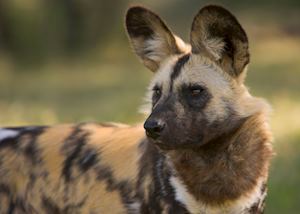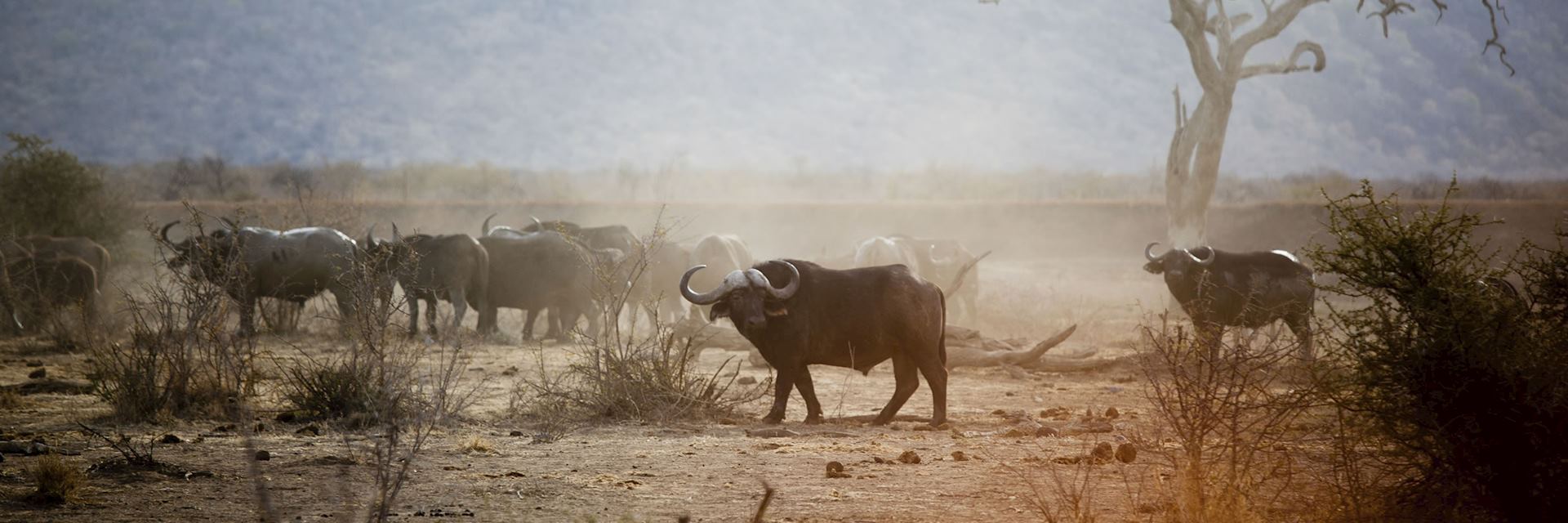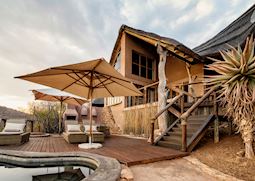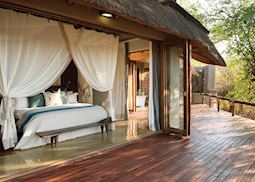Jump to:
A jumble of rocky hills and mountains, seasonal wetlands, wide savannah and bushveld-covered plateaus, Madikwe Game Reserve attracts wildlife big and small. Here, you can see the Big Five, packs of wild dog and more than 300 bird species on daily game drives.
 Situated in northwest South Africa, close to the Botswana border, Madikwe is the country’s fifth-largest game reserve. It’s also malaria-free, yet it sees far fewer visitors than the Kruger and Eastern Cape reserves. It’s not uncommon to have wildlife sightings all to yourself, be it a pride of lion lounging in the shade, a multi-generational herd of elephant splashing into a waterhole, or wild dog warming up for their evening hunt.
Situated in northwest South Africa, close to the Botswana border, Madikwe is the country’s fifth-largest game reserve. It’s also malaria-free, yet it sees far fewer visitors than the Kruger and Eastern Cape reserves. It’s not uncommon to have wildlife sightings all to yourself, be it a pride of lion lounging in the shade, a multi-generational herd of elephant splashing into a waterhole, or wild dog warming up for their evening hunt.
Madikwe is also an example of community-based wildlife conservation, where the land is managed and funded in a way that benefits both the wildlife and local communities.
Madikwe hasn’t always been a game reserve. Its healthy wildlife population stems from a major game relocation that took place during the 1990s, when 8,000 animals were moved to this former farming area for protection.
Today, drive five hours or take a one-hour light aircraft flight northwest of Johannesburg and you can reap the rewards of this conservation effort. Safaris here get you close to lion, elephant, buffalo, giraffe and wild dog, among many other species.
While the density of wildlife isn’t quite on par with some of South Africa’s other reserves (yet), this often makes a safari all the more exciting. Heading out with guides, you can learn tracking techniques, stopping to identify tracks left by big cats on their night-time hunts. And, it feels more rewarding when you do come across game.
Your safari involves twice-daily game drives. One explores at first light as life in the bush awakens, the other in the evening and beyond sunset, giving you a chance to see nocturnal wildlife such as African wildcat and porcupines. Many camps also offer guided bush walks during the day. These focus on the ecosystem’s finer details — the plant life, insects, reptiles and birds you’d miss from a vehicle and natural features of the land, from termite mounds to geological formations.
While you’re out exploring the reserve, you’ll pass through a wide range of landscapes. In the west, the rocky terrain is interspersed with patches of grassland and wildflowers. Dense bushland and open grassy plains dominate the east. Then, throughout the reserve, you’ll find more arid pockets of sand and clay close to the Limpopo River, where you can frequently spot bee-eaters, pied kingfishers and fish eagles.
Between activities, you can spend time relaxing at your camp or lodge, most of which have pools and decks overlooking the surroundings. Then, in the evening, share tales around the dining table under a sky bursting with stars.
Best time to visit Madikwe Game Reserve
For the best wildlife sightings, visit during the dry season, which runs roughly from May to September. As water becomes scarcer, animals gather around waterholes, making them easier to spot.
who's been there

Start planning your tailor-made trip to the Madikwe Game Reserve by contacting one of our South Africa specialists
-
01993 838 92501993 838 550
- Make an enquiry
Places near the Madikwe Game Reserve
- The Pilanesberg National Park 61 miles away
- The Waterberg 76 miles away
- Johannesburg 149 miles away
- Greater Makalali Game Reserve 277 miles away
- The Escarpment 280 miles away
- Blyde River Canyon Nature Reserve 285 miles away
Photos of the Madikwe Game Reserve
Accommodation choices for the Madikwe Game Reserve
We’ve selected a range of accommodation options for when you visit the Madikwe Game Reserve. Our choices usually come recommended for their character, facilities and service or location. Our specialists always aim to suggest properties that match your preferences.
-
![Madikwe Safari Lodge, Madikwe Game Reserve]()
Madikwe Safari Lodge
Madikwe Game Reserve -
![Impodimo Exterior Suite]()
Impodimo Game Lodge
Madikwe Game Reserve -
![Madikwe Hills Private Game Lodge]()
Madikwe Hills Safari Lodge
Madikwe Game Reserve -
![Mateya Safari Lodge]()
Mateya Safari Lodge
Madikwe Game Reserve














